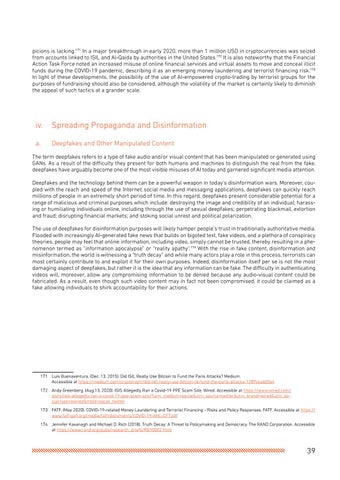picions is lacking.171 In a major breakthrough in early 2020, more than 1 million USD in cryptocurrencies was seized from accounts linked to ISIL and Al-Qaida by authorities in the United States.172 It is also noteworthy that the Financial Action Task Force noted an increased misuse of online financial services and virtual assets to move and conceal illicit funds during the COVID-19 pandemic, describing it as an emerging money laundering and terrorist financing risk.173 In light of these developments, the possibility of the use of AI-empowered crypto-trading by terrorist groups for the purposes of fundraising should also be considered, although the volatility of the market is certainly likely to diminish the appeal of such tactics at a grander scale.
iv. Spreading Propaganda and Disinformation a.
Deepfakes and Other Manipulated Content
The term deepfakes refers to a type of fake audio and/or visual content that has been manipulated or generated using GANs. As a result of the difficulty they present for both humans and machines to distinguish the real from the fake, deepfakes have arguably become one of the most visible misuses of AI today and garnered significant media attention. Deepfakes and the technology behind them can be a powerful weapon in today’s disinformation wars. Moreover, coupled with the reach and speed of the Internet, social media and messaging applications, deepfakes can quickly reach millions of people in an extremely short period of time. In this regard, deepfakes present considerable potential for a range of malicious and criminal purposes which include: destroying the image and credibility of an individual; harassing or humiliating individuals online, including through the use of sexual deepfakes; perpetrating blackmail, extortion and fraud; disrupting financial markets; and stoking social unrest and political polarization. The use of deepfakes for disinformation purposes will likely hamper people’s trust in traditionally authoritative media. Flooded with increasingly AI-generated fake news that builds on bigoted text, fake videos, and a plethora of conspiracy theories, people may feel that online information, including video, simply cannot be trusted, thereby resulting in a phenomenon termed as “information apocalypse” or “reality apathy”.174 With the rise in fake content, disinformation and misinformation, the world is witnessing a “truth decay” and while many actors play a role in this process, terrorists can most certainly contribute to and exploit it for their own purposes. Indeed, disinformation itself per se is not the most damaging aspect of deepfakes, but rather it is the idea that any information can be fake. The difficulty in authenticating videos will, moreover, allow any compromising information to be denied because any audio-visual content could be fabricated. As a result, even though such video content may in fact not been compromised, it could be claimed as a fake allowing individuals to shirk accountability for their actions.
171 Luis Buenaventura. (Dec. 13, 2015). Did ISIL Really Use Bitcoin to Fund the Paris Attacks? Medium. Accessible at https://medium.com/cryptonight/did-isil-really-use-bitcoin-to-fund-the-paris-attacks-1287cea605e4 172 Andy Greenberg. (Aug.13, 2020). ISIS Allegedly Ran a Covid-19 PPE Scam Site. Wired. Accessible at https://www.wired.com/ story/isis-allegedly-ran-a-covid-19-ppe-scam-site/?utm_medium=social&utm_source=twitter&utm_brand=wired&utm_social-type=owned&mbid=social_twitter 173 FATF. (May 2020). COVID-19-related Money Laundering and Terrorist Financing - Risks and Policy Responses. FATF. Accessible at https:// www.fatf-gafi.org/media/fatf/documents/COVID-19-AML-CFT.pdf 174 Jennifer Kavanagh and Michael D. Rich (2018). Truth Decay: A Threat to Policymaking and Democracy. The RAND Corporation. Accessible at https://www.rand.org/pubs/research_briefs/RB10002.html
39












